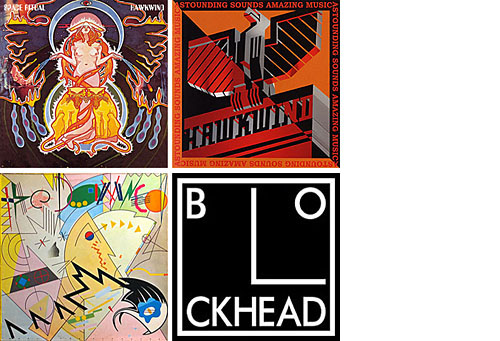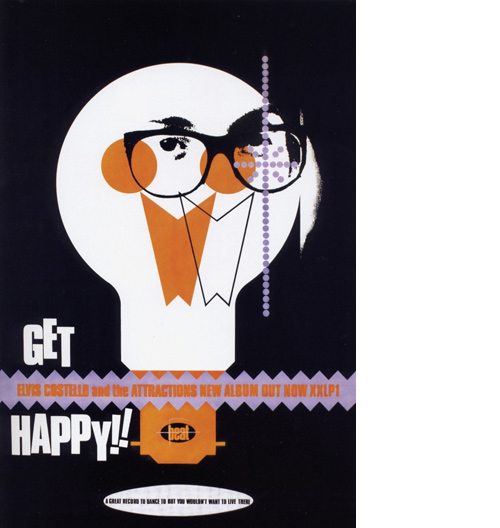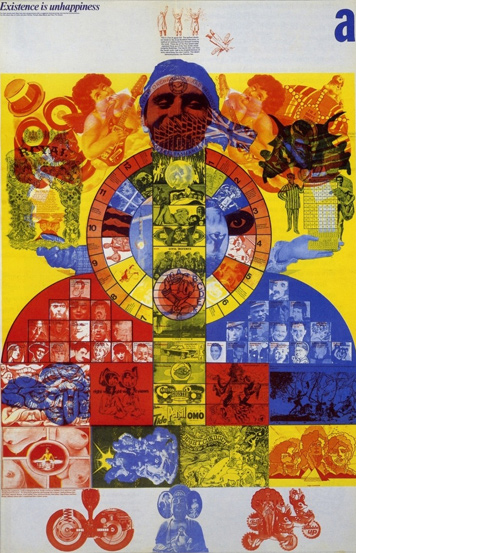Typophile 4
Thank you Jenny Green!
Barney Bubbles
 I had never seen or heard his name until I saw this thumbnail sized picture of Reasons to be Cheerful: The Life and Work of Barny Bubbles at DesignObserver. But as a young punk rock slash new waver in the late 1970s, I knew his work. I admired it all the way into a career in graphic design slash graphic design pedagogy. And yet I never knew his name. That’s not surprising, though. By the end of his career Barney worked anonymously or pseudonymously (that is to say, with a credit that was at least cryptic). Finally, through the book and by way of friends and fans, his story is being told. I haven’t read or seen the book yet, but I’ve been snooping around the internet . . . and these are a few of my favorite online Barney Bubbles information resources:
I had never seen or heard his name until I saw this thumbnail sized picture of Reasons to be Cheerful: The Life and Work of Barny Bubbles at DesignObserver. But as a young punk rock slash new waver in the late 1970s, I knew his work. I admired it all the way into a career in graphic design slash graphic design pedagogy. And yet I never knew his name. That’s not surprising, though. By the end of his career Barney worked anonymously or pseudonymously (that is to say, with a credit that was at least cryptic). Finally, through the book and by way of friends and fans, his story is being told. I haven’t read or seen the book yet, but I’ve been snooping around the internet . . . and these are a few of my favorite online Barney Bubbles information resources:
 http://www.johncoulthart.com/feuilleton/?p=1296
http://www.johncoulthart.com/feuilleton/?p=1296
 http://www.designobserver.org/archives/entry.html?id=38870
http://www.designobserver.org/archives/entry.html?id=38870
http://en.wikipedia.org/wiki/Barney_Bubbles

http://davidwills.wordpress.com/
beige, rust, and cocoa-brown
“Favoring beige, rust, and cocoa-brown in his professional wardrobe, soft and round-faced and vestigially freckled, with a helmetish haircut and a smile that always looked pained no matter how real the cheer, Terry Schmidt had been described by one of Scott R. Laleman’s toadies in Technical Processing as looking like a ’70s yearbook photo come to life.”
—David Foster Wallace, “Mister Squishy,” Oblivion, 2004.
the kind of green people buy tinted contact lenses to get
“Fern, by the way, has reddish hair and slightly asymmetrical green eyes—the kind of green people buy tinted contact lenses to get—and is attractive in a sort of witchy way. I think she’s attractive, anyway.”
—David Foster Wallace, “Good Old Neon,” Oblivion, 2004.
a whitecap on the surface of the ocean
“Dr. G. would later say that the whole my life flashed before me phenomenon at the end is more like being a whitecap on the surface of the ocean, meaning that it’s only at the moment you subside and start sliding back in that you’re really even aware there’s an ocean at all. When you’re up and out there as a whitecap you might talk and act as if you know you’re just a whitecap on the ocean, but deep down you don’t think there’s really an ocean at all. It’s almost impossible to. Or like a leaf that doesn’t believe in the tree it’s part of, etc. There are all sorts of ways to try to express it.”
—David Foster Wallace, “Good Old Neon,” Oblivion, 2004.
the definition of good art
“In dark times the definition of good art would seem to be art that locates and applies CPR to those elements of what’s human and magical that still live and glow despite the times’ darkness.”
—David Foster Wallace, from an interview with Larry McCaffrey published in The Review of
Contemporary Fiction in 1993.
a native of the rain forest
“If you are a native of the rain forest, you learn to distinguish many sorts of leaves. We learn to distinguish many different typefaces.”
—Virginia Postrel, “Pricing Beauty: Reflections on Aesthetics and Value, An Interview with Virginia Postrel,” Gain 2.0, AIGA Business and Design Conference, September 2002; quoted in A Whole New Mind, by Daniel H. Pink, 2005.
a lavender Cadillac
“I want a lavender Cadillac
Don’t want it green or blue or black
Just a lavender Cadillac”
—“I Want a Lavender Cadillac,” Maurice King & His Wolverines with Bea Baker, 1952.
Micro-artist hits the big-time
his [the interrogator’s] big rings
“And Mitya, as he remembered, suddenly became terribly interested in his [the interrogator’s] big rings, one with an amethyst, and another with a bright yellow stone, transparent and of a most wonderful brilliance. And for a long time afterwards he recalled with surprise how these rings irresistibly drew his eye even through all those terrible hours of interrogation, so that for some reason he was unable to tear himself away and forget them as something quite unsuitable in his position.”
—Fyodor Dostoevsky, The Brothers Karamazov, 1880, translated by Richard Pevear and Larissa Volokhonsky, 1990.